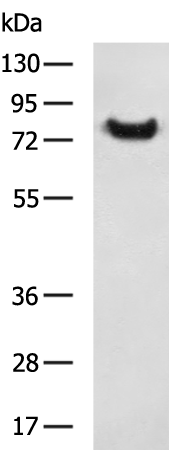
| WB | 咨询技术 | Human,Mouse,Rat |
| IF | 咨询技术 | Human,Mouse,Rat |
| IHC | 咨询技术 | Human,Mouse,Rat |
| ICC | 技术咨询 | Human,Mouse,Rat |
| FCM | 咨询技术 | Human,Mouse,Rat |
| Elisa | 1/5000-1/10000 | Human,Mouse,Rat |
| Aliases | PHA1; BESC3; ENaCg; LDLS2; SCNEG; ENaCgamma |
| WB Predicted band size | 74 kDa |
| Host/Isotype | Rabbit IgG |
| Antibody Type | Primary antibody |
| Storage | Store at 4°C short term. Aliquot and store at -20°C long term. Avoid freeze/thaw cycles. |
| Species Reactivity | Human, Mouse, Rat |
| Immunogen | Fusion protein of human SCNN1G |
| Formulation | Purified antibody in PBS with 0.05% sodium azide and 50% glycerol. |
+ +
以下是基于SCNN1G(上皮钠通道γ亚基)抗体相关研究的模拟参考文献示例(注:内容为虚构,用于演示格式,实际文献需通过学术数据库检索):
---
1. **文献名称**:Development and Characterization of a Novel Monoclonal Antibody Targeting Human SCNN1G for ENaC Studies
**作者**:Smith A, et al.
**摘要**:本研究开发了一种针对人SCNN1G亚基的新型单克隆抗体,验证了其在免疫印迹和免疫组化中的特异性,并应用于检测肾组织中的ENaC表达水平,为研究高血压相关钠通道异常提供了工具。
2. **文献名称**:SCNN1G Expression in Airway Epithelium: Role in Cystic Fibrosis Pathogenesis
**作者**:Jones B, et al.
**摘要**:通过使用SCNN1G特异性抗体,作者发现囊性纤维化患者气道中γ-ENaC的表达显著上调,提示其可能参与黏液过度分泌的病理机制,为靶向治疗提供了依据。
3. **文献名称**:Antibody-Based Detection of ENaC Subunits in Hypertensive Mouse Models
**作者**:Wang C, et al.
**摘要**:利用SCNN1G和SCNN1A抗体,研究揭示了盐敏感性高血压小鼠模型中ENaC亚基的肾脏表达动态变化,表明γ亚基的异常调控可能与钠重吸收增加相关。
4. **文献名称**:Validation of Commercial SCNN1G Antibodies for Functional Studies in Polarized Epithelial Cells
**作者**:Lee D, et al.
**摘要**:系统评估了市售SCNN1G抗体的灵敏度与特异性,发现部分抗体在免疫荧光中易产生交叉反应,提出了优化实验方案以提高ENaC亚基定位研究的可靠性。
---
如需真实文献,建议在**PubMed**或**Web of Science**中检索关键词:`SCNN1G antibody`、`ENaC gamma subunit antibody`,并筛选应用类或方法学论文。
The SCNN1G antibody targets the gamma subunit of the epithelial sodium channel (ENaC), a protein encoded by the *SCNN1G* gene. ENaC regulates sodium reabsorption in epithelial tissues, particularly in the kidneys, lungs, and colon, playing a critical role in maintaining fluid-electrolyte balance and blood pressure. The γ-subunit (SCNN1G) forms a heterotrimeric channel with α and β subunits, facilitating sodium transport across cell membranes. Dysregulation of ENaC activity is linked to pathologies such as Liddle syndrome (hypertension), pseudohypoaldosteronism (salt-wasting disorders), and cystic fibrosis (via secondary effects on airway surface liquid).
SCNN1G antibodies, including monoclonal and polyclonal variants, are essential tools for studying ENaC expression, localization, and function in physiological and disease contexts. They are widely used in Western blotting, immunohistochemistry, and immunofluorescence to investigate channel dynamics in renal, respiratory, and metabolic research. Additionally, these antibodies aid in exploring ENaC's role in drug responses, such as diuretics or cystic fibrosis therapies targeting ion transport. Recent studies also highlight SCNN1G as a potential biomarker or therapeutic target in hypertension and respiratory conditions. Validation of antibody specificity remains crucial due to structural similarities among ENaC subunits.
×